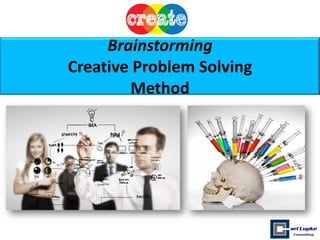
Brainstorming Creative problem solving method
- 2. Session objectives • What is brainstorming? • Why and when use it? • How to organise and lead a successful brainstorming session? • What mistakes are to be avoided? • Additional creative problem solving methods
- 3. What is brainstorming „The best way how to have a good idea is to have many ideas“ – Alex F. Osborne, 1939 • method of thinking up solutions, concepts, ideas in problem solving • using the brain to storm new ideas in groups • „It is easier to tone down a wild idea than to think up a new one.“
- 4. Why and When to Use It • the creative process is not always easy (problems of fear, criticism, no existing solutions yet) • one person has a limited capacity • people tend to judge new ideas immediately (a change is difficult for a human being) Creative thinking require appropriate tools !
- 5. How does it work • in a group of people • free associations to the topic given • relaxed and friendly atmosphere • deferred judgements – release the human mind, lateral thinking As many ideas as possible, no matter how crazy they are
- 6. The Key Rules 1. relaxed atmosphere - completely free 2. no criticism or judgements 3. quantity matters 4. all ideas legitimate 5. all ideas put on the sheet of paper 6. evaluation only after the session
- 8. Why and When Use It Specific questions: - How can we promote our products? - What can our company do in 5 years hence? - What can we do to solve the problem XY? - How can we improve co-operation of A and B? - What do our customers really want? - What opportunities do we have this year? - How can we have more fun at work?
- 9. • does not rank the ideas • cannot help you select the important ones • does not suggest the best solutions • must be amended by other methods BRAINSTORMING CONSTRAINTS
- 10. Organising a session? 1. PREPARATION PHASE 2. CONDUCT THE SESSION 3. EVALUATION
- 11. 1. PREPARATION PHASE Specify the problem What do we really want? Select the right people up to 10 – 12 different positions Decide when and where place and time matters „U“ layout of the room Invite people make sure they have time
- 12. 1. Specify the objectives – make sure that everybody is happy with the central question. 2. Decide the roles: - leader, recorder, panel. 3. Explain the rules (or make sure that everybody knows them. Eventually – a warm-up exercise for fun). You can let people to jot down a few ideas before starting. 4. Begin by going around, after some rounds, open the floor. 5. Record the ideas exactly, clarify only in the end. 6. Suspend judgements ! 7. Encourage the ideas, even the most radical and far-fetched. Allow the late coming ideas, do not hurry. 8. At the end – eliminate duplicates, clarify, thank the participants. 2. CONDUCT THE SESSION
- 13. 3. EVALUATION PHASE Put the evaluation off / next day Add newly born ideas to the list Group similar ideas together Select the best or most interesting suggestions Create teams which will work on them further Inform people about the results
- 14. Mistakes to be avoided • people are negative in advance (it will not work anyway) • too many brainstormings in the company • bad atmosphere in the beginning • bad experience with the method • judgements occur during the session • any criticism and personal attacks
- 15. Additional creative problem-solving methods INDIVIDUAL BRAINWRITING COLOURFUL CARDS MIND MAPS
- 16. When? - When you need to solve some problem alone, and you do not have a group to work with How? - A piece of paper (can be big and colourful to stimulate your thinking). - Jot down all ideas linked with the issue. - !! Do not judge yourself !! - further steps as in brainstorming INDIVIDUAL BRAINWRITING
- 17. When? - in a group of people, sensitive topic (eg. What do we like / dislike about our managers, company?) How? - a set of papers / person (smaller pieces, A4/3 or 3M), colours as needed, for example yellow and green - people individually note their opinions on the cards, one idea per card, yellow – positive, green – negative - glue the cards on the flip chart, grouping immediately similar opinions together, negative on the left, positive on the right - let people see and discuss the result - brainstorming on What can we do about it? can follow COLOURFUL CARDS
- 18. linear form WHAT is it? - alternative way of making notes and mapping any issue - many well-known thinkers used some form of it (Leonardo da Vinci) - does not use linear form of notes, but EXPLOSIVE - using colours, pictures and symbols WHY? - uses natural brain processes - stimulate thinking, fun, joy explosive form * eg. Tony Buzan, The Creative Intelligence MIND MAPS
- 19. MIND MAPS
- 20. Durban history culture transport Capital city restaurants and good food architecture HOW TO USE MIND MAPS
- 21. to make a daily schedule notes of the lesson, books, articles holiday planning shopping list to do list every day, as often as possible, be creative, develop your own style with time, have fun also in groups after brainstorming session WHEN TO USE MIND MAPS
- 22. SUMMARY • creativity is not born by itself • creative methods must be consciously introduced and developed in organisations • people must be encouraged to use them, with no fear to make mistakes, prized for new ideas • support from top management needed • good preparation and patience Have fun and all the best !
